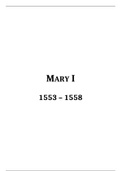MARY I
1553 – 1558
,BACKGROUND OF MARY I
Mary I gained popular support, once Lady Jane Grey was proclaimed Queen in 1553.
Northumberland was forced to surrender to Mary.
This showed how secure the Tudor dynasty had become, since the only successful coup against the
Tudors lasted just nine days.
Mary imprisoned Northumberland and Lady Jane Grey in the Tower, and were both executed.
Initially, Mary was reluctant to execute Lady Jane Grey, but she represented hope for English Protestants
as long as she remained alive, especially following Wyatt’s Rebellion.
Mary's accession was greeted favourably by the English people.
It has been debated whether this was because the English people supported the legitimate succession, or
because they welcomed the return of Catholicism.
Failure of the Devyse
Northumberland's plans failed for a number of reasons.
He had attempted to interfere with the legitimate succession, and to compound this by promoting the
claims of his sons wife.
This led to many people believing he did this to hold onto power.
His behaviour was illegal, and accept some of his more committed supporters on the Council.
Northumberland had a little positive support, despite the fact that he didn't alienate his support as
Somerset had.
Mary, on the other hand, acted bravery, decisively and quickly.
This meant she was able to gather support from the nobility, gentry and the ordinary people.
, GOVERNMENT UNDER MARY I
Under Mary I, the role of the Privy Council became more established, and committees were used to deal
with specialised issues, such as the war with France.
For Mary, the restoration of the Catholic faith took priority over all other issues of government.
However, this created many problems.
o She had inherited a kingdom that had fundamental religious divisions.
o She was catholic in a kingdom which had a large Protestant minority.
o She had not been brought up to rule, and had a little political instinct.
o Many of her loyal and trusted supporters had no serious experience in government.
o She would have to rely on those who had served Edward VI, who were implicated in the
introduction religious reforms that were distasteful to her.
The Council
Mary’s new councillors included:
o Bishop Stephen Gardiner, who had been her father's secretary, and being imprisoned during
Edward's reign.
o Other churchmen, who had been excluded from influenced during Edwards reign.
o Some of the more Conservative councillors, who had served Edward, such as Lord Paget.
Mary was never quite at ease with the councillors.
She lost confidence in Paget due to his opposition to her religious programme.
She never fully trusted Gardiner, as he failed to support her mother at the time of the Break with Rome.
However, she saw Gardiner as indispensable, and his role in government was never satisfactorily filled
following his death in 1555.
This was especially because Cardinal Pole distance themselves from secular issues.
Consequently, Mary relied on the advice of two foreigners: Philip of Spain (her husband) and Simon
Renard (her cousin and father-in-law, Charles V's ambassador).
Parliament
The relationship between Mary and Parliament was one of cautious cooperation.
A substantial minority of MPs oppose the reversal of Edwardian religious legislation.
There were also other examples of opposition to Crown policies.
Concern for property rights, which were motivated by self-interest in most cases, ensured that ex-
monastic property would not be restored to the Church. Mary did not press this point.
A bill in 1555 allowing the seizure of property of Protestant exiles was defeated.
Mary also quarrelled with the Parliament over the issue of succession.
Developments
Mary’s government was credited with reviving England’s military and naval traditions, providing
Elizabeth with the means to resist Spain, during her reign.
Under Northumberland, the maintenance of the royal fleet was allowed to slip, and a number of ships
had been decommissioned.
By the end of her reign, the fleet was at the same level it had been at the end of Henry VIII’s reign.
The government also modernised the army, through the Militia Act and Arms Act of 1558.
The 1558 Militia Act laid down a system which was responsible for the recruitment of regional militias
during wartime.
The 1558 Arms Act established better procedures for supplying weapons into royal forces.





